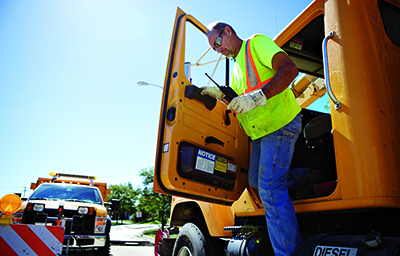One touch, no reach. Those are the two fundamentals for using two-way radios (walkie-talkies) safely while driving.  Federal regulations forbid the use of cellphones and sending text messages while driving commercial vehicles. However, these statutes do not prohibit the use of two-way radios, but they do offer guidelines for keeping radio users safe while driving on company business.
According to federal regulators, the two greatest risks of using a cell phone while driving are reaching to grab one and using more than one button to operate it. Commercial drivers are allowed to use hands-free phones, provided they can operate the phone without reaching and by touching a single button.
These same concepts apply to the safe use of two-way radios while driving.
Federal regulations forbid the use of cellphones and sending text messages while driving commercial vehicles. However, these statutes do not prohibit the use of two-way radios, but they do offer guidelines for keeping radio users safe while driving on company business.
According to federal regulators, the two greatest risks of using a cell phone while driving are reaching to grab one and using more than one button to operate it. Commercial drivers are allowed to use hands-free phones, provided they can operate the phone without reaching and by touching a single button.
These same concepts apply to the safe use of two-way radios while driving.
 MOTOROLA, MOTOROLA SOLUTIONS and the Stylized M Logo are trademarks or registered trademarks of Motorola Trademark Holdings, LLC and are used under license. All other trademarks are the property of their respective owners. ©2015 Motorola Solutions, Inc. All rights reserved.
MOTOROLA, MOTOROLA SOLUTIONS and the Stylized M Logo are trademarks or registered trademarks of Motorola Trademark Holdings, LLC and are used under license. All other trademarks are the property of their respective owners. ©2015 Motorola Solutions, Inc. All rights reserved.
 Federal regulations forbid the use of cellphones and sending text messages while driving commercial vehicles. However, these statutes do not prohibit the use of two-way radios, but they do offer guidelines for keeping radio users safe while driving on company business.
According to federal regulators, the two greatest risks of using a cell phone while driving are reaching to grab one and using more than one button to operate it. Commercial drivers are allowed to use hands-free phones, provided they can operate the phone without reaching and by touching a single button.
These same concepts apply to the safe use of two-way radios while driving.
Federal regulations forbid the use of cellphones and sending text messages while driving commercial vehicles. However, these statutes do not prohibit the use of two-way radios, but they do offer guidelines for keeping radio users safe while driving on company business.
According to federal regulators, the two greatest risks of using a cell phone while driving are reaching to grab one and using more than one button to operate it. Commercial drivers are allowed to use hands-free phones, provided they can operate the phone without reaching and by touching a single button.
These same concepts apply to the safe use of two-way radios while driving.
Addressing the threat and liability of distracted driving
Regulators’ warnings about the hazards of distracted driving put it this way: Taking your eyes off the road for only a few seconds in a car going 55 mph is like driving the length of a football field wearing a blindfold. Distracted driving killed 3,154 people in 2013 and injured another 424,000, according to the Department of Transportation. The widespread carnage of distracted driving spurred federal regulators to ban the use of cell phones while driving large commercial vehicles. Fourteen U.S. states and the District of Columbia also ban drivers from using cellphones while driving. And while two-way radios are generally exempt from such rules, employers who want to avoid substantial fines and crippling lawsuits need to ensure their employees use their radios safely while driving on the job. Employers are generally considered legally liable for the actions of staffers behind the wheel on company business. That means if a member of your construction crew has his foot slip off the brake while he’s reaching across the seat for a communications device and the truck knocks down a garage the carpenters just finished, you could be sued to pay for the repairs. And, if people get injured or killed, the liability increases exponentially.How the cell phone ban relates to Motorola two-way radios
When federal regulators imposed the ban against truckers and other commercial drivers from using cell phones, they had two points in mind:- The simple act of reaching for an item like a cell phone is a lot more dangerous than you might think. People are three times more likely to have an accident while reaching for something than when not reaching, regulators noted.
- Attempting to dial a phone number is generally more hazardous than the simple Push-To-Talk operation of two-way radios. While commercial drivers are permitted to use a cell phone if they can activate it by touching a button while keeping their eyes on the road, it must be done comfortably while seated with the safety belt fastened, and it cannot require reaching.
Ensuring one-touch use for two-way radios
Operation of portable two-way radios and mobile radios mounted in vehicles often requires less reaching and less manipulation of buttons and screens to operate than cell phones. The key is ensuring that professionals who drive and use radios can do so with less distraction and without having to reach for them, and by touching only one button. There are three ways to make this happen:- A mounting clip near the steering wheel. For portable radios, a well-placed clip near the steering wheel is probably the most basic and straight-forward way to ensure your drivers can use their radios while keeping their eyes on the road.
- Mobile radios. In-vehicle radios must be installed properly so drivers can easily talk into the microphone. If you expect your employees to do a lot of radio communications while driving, they really need to rely on a mobile rather than a portable radio.
- Bluetooth headsets. Many digital Motorola Solutions handheld radios include wireless Bluetooth connectivity. If your workers are already requesting these headsets for other needs, you have one extra argument in its favor: It will be safer in their vehicle(s).
About BearCom
BearCom provides a broad line of high-performance wireless communications products, services, and complete mobility solutions. Founded in 1981, BearCom is America’s only nationwide dealer and integrator of wireless communications equipment, serves customers from 29 branch offices located throughout the U.S., and employs approximately 360 people. BearCom is headquartered in the Dallas, Texas area. MOTOROLA, MOTOROLA SOLUTIONS and the Stylized M Logo are trademarks or registered trademarks of Motorola Trademark Holdings, LLC and are used under license. All other trademarks are the property of their respective owners. ©2015 Motorola Solutions, Inc. All rights reserved.
MOTOROLA, MOTOROLA SOLUTIONS and the Stylized M Logo are trademarks or registered trademarks of Motorola Trademark Holdings, LLC and are used under license. All other trademarks are the property of their respective owners. ©2015 Motorola Solutions, Inc. All rights reserved.




